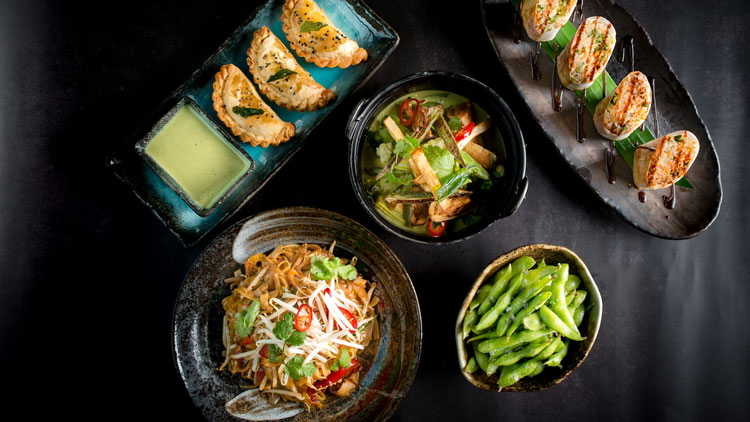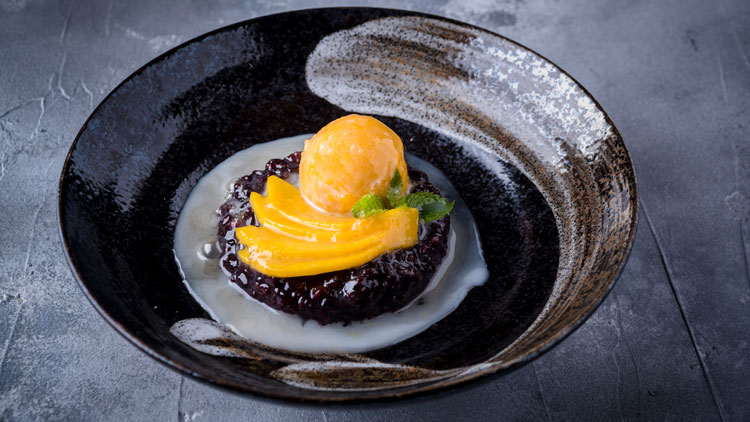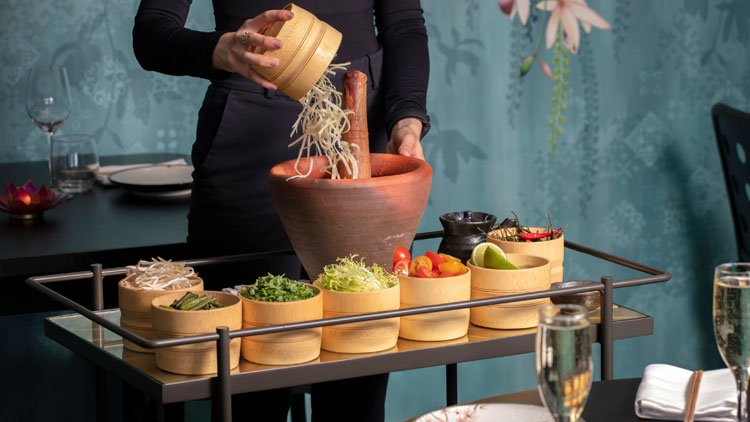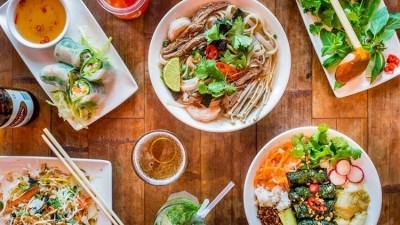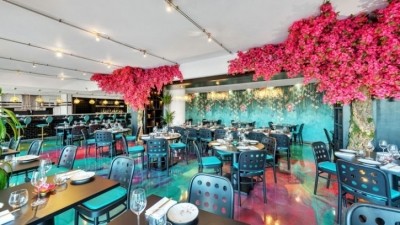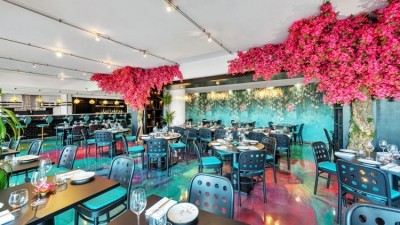long read
“It’s not made for the purists” – Peter Lloyd on Sticky Mango’s expansion
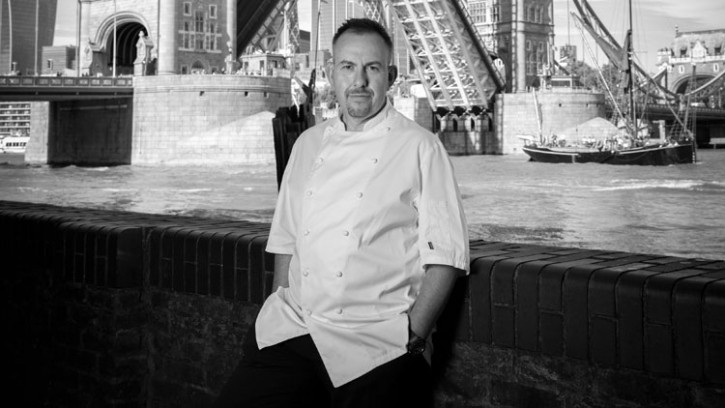
“The biggest lesson I’ve learnt so far is that just because you’ve got one successful restaurant, it doesn’t mean your second is going to hit the ground running,” says Peter Lloyd, when asked about the opening of Sticky Mango Tower Bridge. It’s a decidedly candid and somewhat unexpected answer. Often chefs and restaurateurs will go out of their way to tell you everything is going to plan with their latest opening, even when it’s apparent that that’s not entirely the case. But Lloyd, who launched Sticky Mango as a pop up back in 2016 and opened his first permanent site under the luxury pan Asian brand in London Waterloo the following year, is under no allusions when it comes to building a successful restaurant.
“We’re seven years old this month and to get the business to where it is has taken a lot of time and a lot of risk,” he continues. “And now we want to replicate that success at Tower Bridge. But while it took us six years to get to where we wanted to be at Waterloo, here we’re trying to do it in a matter of weeks.”
Housed in D&D London’s former Cantina del Ponte site on Shad Thames, overlooking Tower Bridge, Sticky Mango’s second restaurant boasts an impressive but undeniably tough location. Much of the area’s footfall from both tourists and office workers is concentrated closer to London Bridge and the myriad of chain restaurants located there, meaning anyone looking to make their mark further along the riverbank has to work doubly hard to draw in diners.
“We’re seven years old this month and to get the business
to where it is has taken a lot of time and a lot of risk”
When I meet Lloyd at the restaurant on a grey and overcast Thursday in late September, the scale of that challenge is clear. It’s lunchtime, and just a few solitary tables are occupied. “We’ve been open four weeks now and the truth is it’s not working at the moment,” admits Lloyd. “It’s at that beginning stage. We don’t have the budgets that the bigger restaurant groups have, we can’t spend thousands on marketing. We’ve put all chips on red and we’re working hard to get that exposure out there, but it’s not as easy as you think.”
An exhilarating moment
Lloyd has an impressive CV that spans more than 25 years. He cut his teeth as a commis chef at The House of Commons and later at The Dorchester on Park Lane, and has staged for the likes of Pierre Koffmann, Gordon Ramsay, Marco Pierre White and Charlie Trotter. He scored his first head chef gig at the age of 23, overseeing the stoves at RSJ Restaurant in Waterloo, and subsequently went on to work as a private chef to Lord and Lady Bamford, the billionaire owners of manufacturing company JCB.
While his training was ostensibly in classical French cooking, he describes himself as a curious chef keen to learn about different cuisines. “I was engrossed in the industry from the start,” he says. “And that gave me the skill to be creative. By 25 I had more than 100 cookbooks, and I was learning new methods and flavour combinations all the time.”
His interest in Southeast Asian cuisine, which would eventually lead to the development of the Sticky Mango brand, came about after he took on the role of executive chef at the five-star Sanderson Hotel in Fitzrovia. When he took the job, he inherited a Malaysian restaurant called Suka, with the original plan was to relaunch it as a French fine dining restaurant. When that didn’t happen, he decided to give it a go himself, a decision he describes as “exhilarating”.
Trips to Kuala Lumpa and Langkawi soon followed, as Lloyd sought to immerse himself in the Malaysian culture and understand the dynamics of the cuisine. “Malaysian food is so complex – the flavours, the preparation – and it intrigued me.” The job lit a spark in Lloyd, and with later trips to Thailand, Singapore and Indonesia, he began exploring the breadth of other cuisines within the Southeast Asia region. “I had never felt so stimulated, so I chose to pursue it.”
In 2016, after a number of years working as executive chef at Spice Market at The W Hotel, Jean-Georges Vongerichten’s now-closed Southeast Asian restaurant in Leicester Square, Lloyd felt ready to do his own thing. This led to the launch of Sticky Mango’s original pop up, housed in the basement below the same RSJ Restaurant in Waterloo that had given him his first head chef role. It was an instant hit.
“We often had a queue of people wanting to get into this little basement restaurant we had created,” recalls Lloyd. “We opened in October 2016, and by Christmas we were ranked number one London restaurant on Tripadvisor. It was insane and completely ridiculous, but it showed that people were dazzled by what we were doing.”
The concept has undergone several evolutions in the intervening years, but the fundamental idea remains the same – to explore the flavours of Southeast Asian street food within a contemporary, finer dining setting. “I could see I was doing something different. At the time we launched, there were hundreds of chefs doing classical French and Italian cooking, but there wasn’t many representing the food of Southeast Asia. I loved the region and the culture, and more importantly, I thought the food was incredible. And I was very proud to become an ambassador for it.”
RSJ shut its doors in 2017 and Sticky Mango took over all three floors of the building on a permanent basis, with positive reviews from Fay Maschler, Giles Coren and Marina O’Loughlin bolstering the restaurant’s profile in the ensuing months.
Restaurant sites arriving like buses
Had the Covid-19 pandemic not happened in, Lloyd believes Sticky Mango would have expanded earlier, but the impact of those two years meant it wasn’t until early 2022 that he begun to seriously think about growing the business. The business has no investors and is run by Llyod and his wife Rosa D’Imperio alongside its team.
Unsurprisingly, Lloyd was initially apprehensive about committing to a second site. But then Tower Bridge came on the market, and he had the chance to take it for what he says was “a snip of its value”.
“People like us don’t get the opportunity to own restaurants like this unless there’s a crisis in the industry. It’s one of the most prominent locations in London. We were in the right place at the right time.”
Lloyd put in an offer, but it took much longer than expected to clear. Ann that time, he received another offer, to take on a site in Islington. “I thought: ‘Ok, this is our moment, let’s throw everything we can at it’. So, we kind of jumped in with both feet.”
With both new restaurants now open, Lloyd makes no attempt to play down the challenge of having tripled the size of his business almost overnight. “It will be quite a seismic shift if we can make it work, and if we can’t then we step back and rebuild,” he says with candour.
“People like us don’t get the opportunity to own
restaurants like this unless there’s a crisis in the industry”
“The landscape has shifted dramatically, particularly in the last 18 months. Running a restaurant is a lot harder now. There’s both a staff and skills shortage. Plus, costs have rocketed by up to 30% and obviously you can’t raise your prices that high.
“The hardest thing is being able to offer value for money and still stick to what your concept is. You have to adapt to what your surroundings are, and if you still want your customers to come when they have less money in their pocket then you have to evolve. If you stand on your laurels, then you’re going to fail.”
A versatile concept
Lloyd describes Sticky Mango as being very versatile, with both Islington and Tower Bridge positioning themselves slightly differently to Waterloo. The former, given its neighbourhood location and smaller size, is more family orientated with an emphasis on sharing plates. This includes a new selection of satay skewers barbecued on a robata grill that will be exclusive to the restaurant.
At Tower Bridge, meanwhile, which has been billed as the group’s new flagship restaurant, the focus is on creating a more immersive and theatrical dining experience. “When you think about what people want from a dining experience in today’s world, the answer is they want moments they can share. They’re looking for content to show how amazing their evening was, so that’s a direction we want to concentrate more on.”
Theatre has long been a fixture of the brand, particularly when it comes to its namesake dish. The name Sticky Mango comes straight from the dessert that’s prevalent in some form across much of Southeast Asia. “I always wanted the name to be fun and quirky, and easy to remember,” says Lloyd. “I’m not of Asian descent and I didn’t want an Asian name. Through my experience of running restaurants, I knew that you sold around 30% desserts to every main, so it was also about trying to up our dessert orders by making it our signature dish.”
In its original iteration, the sticky mango dessert featured a bed of white sticky rice topped with a ‘fried egg’ consisting of a mango puree yolk surrounded by a coconut and vanilla jelly for the white and served with a whipped condensed milk – a modern take on a very traditional dish, as Lloyd calls it. The design has since changed into something that can fairly be described as more being more Insta friendly. Inspired by a recent trip to Bali and Indonesia, the eponymous dessert sees a bed of black sticky rice topped with fresh mango and mango sorbet that’s then covered with a dome of candyfloss. It is then finished tableside with a pour of vanilla-infused coconut milk that causes the candyfloss to dissolve, revealing the main dish.
Daring to be different
Every element of Sticky Mango is informed by Lloyd’s travels to the region. The restaurant’s flamboyant floral design, complete with blossom trees and trailing orchids, is meant to evoke the colours and feelings of being in Southeast Asia: the epoxy resin floor at Tower Bridge, patterned with Southeast Asian pastels, is symbolic of Thailand’s turquoise waters; the abundance of hibiscus across all three sites a nod to the restaurant’s Malaysian influences.
Then there’s the food, which Lloyd openly says is ‘unashamedly created’ in his own image. “The food is reflective of the stories of my travels, and my own creativity.”
Recent trips to Vietnam, for example, have led to the addition of cha ca la vong on the Tower Bridge menu. While normally made with grilled catfish, Lloyd’s version instead features monkfish that’s marinated in a traditional turmeric-based sauce and then cooked tableside with dill and spring onions. He’s also added a new Vietnamese pho dish that’s made with wagyu beef.
Then there are the desserts, which are perhaps most reflective of Lloyd’s creative vision. “Southeast Asian desserts don’t always meet the Western palate, and so I put a lot of emphasis in exploring that,” he says. Other mainstays include his own take on kaya toast, a traditional Singaporean breakfast dish that commonly sees toast that’s buttered and topped with coconut jam and served alongside a soft-boiled egg doused in soy sauce for dipping. Lloyd swaps the toast for a pandan macaron that’s spread with the jam and served with a soy sauce ice cream.
“It’s not made for the purists,” he says with a smile. “We’re not just knocking out everyday recipes. I feel like we have to try harder as we’re one of the underdogs.”
I ask if that feeling is compounded by the recent growth in the capital of more authentic, regionally focused Southeast Asian concepts, particularly within the Thai space, such as Kiln in Soho or Luke Farrell’s Plaza Khao Gaeng that’s housed within Arcade Food Hall.
“No,” comes the immediate response. “I love going to those restaurants. They’re fantastic at what they do, which is honour the original cuisine with more modern cooking techniques. And they don’t stray too far from that. By contrast, we try to move away from some of those traditions. Not in all cases, but most. We have some traditional dishes [the curry puffs have been a fixture on the menu since the pop-up days], but often we try to balance it out with more something more daring.”
Continuous evolution
Lloyd’s focus right now is ensuring the restaurants in Tower Bridge and Islington are operating in line with the one in Waterloo. But his hope is that once they’ve both bedded in he can return to Southeast Asia and look at evolving the menus. “It’s a constant learning process,” he says. “There are still places in the region I haven’t discovered. You can learn about different dishes as much as you want and try to adapt them, but until you visit a country, you’re never going to truly understand its cuisine.”
Future expansion could also be on the cards. “Indonesian food is something I’d like to explore more. I have an idea in my head for a concept that focuses on the more unknown dishes from there. Indonesia has 2,500 listed national dishes, but people over here are often only familiar with a few of them.”
“I’m determined to try and make this work and grow it when I can”
In the short term at least, his focus is on having a more than one day off in a row. “Right now, I’m absolutely knackered, but I’m loving it,” he says, with an infectious zeal that permeates the entire interview.
“I have bundles of energy. I’m working more hours than I ever have in my life. I’m determined to try and make this work and grow it when I can.”
